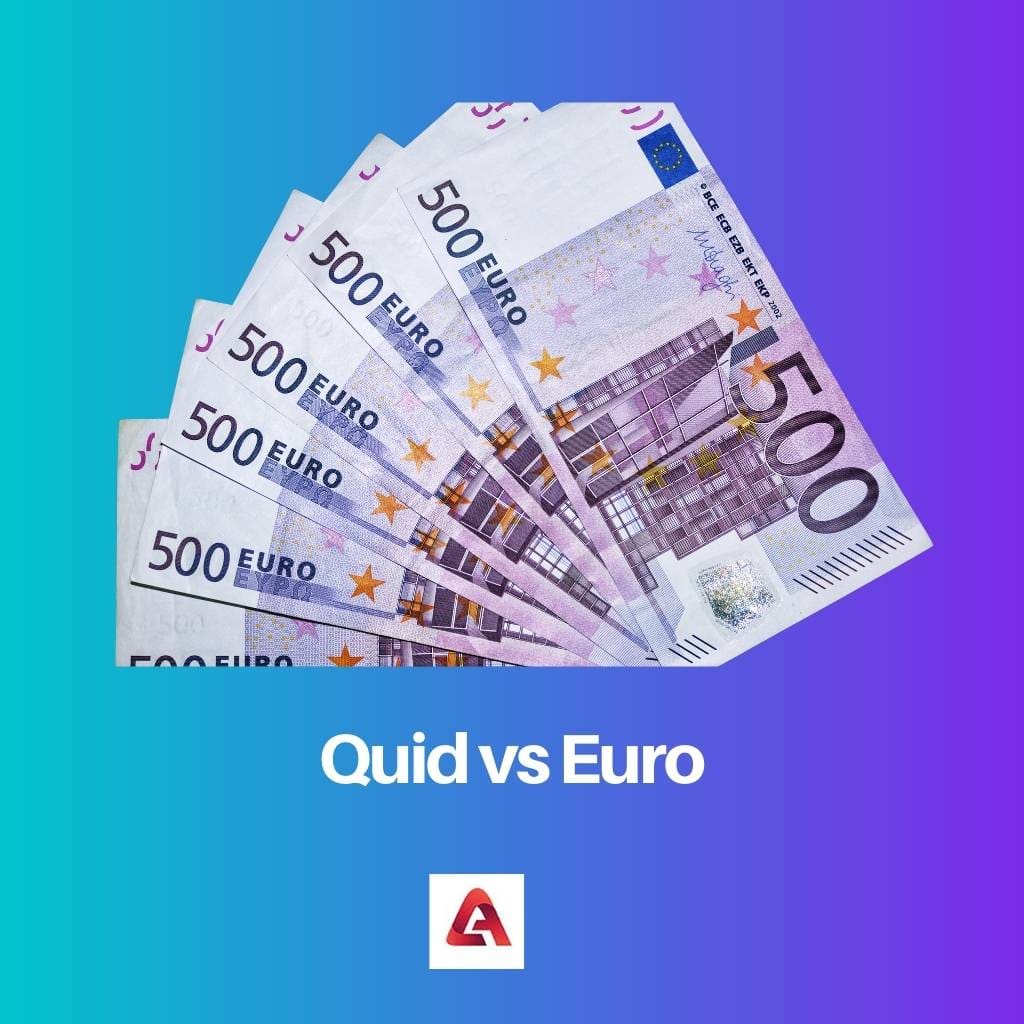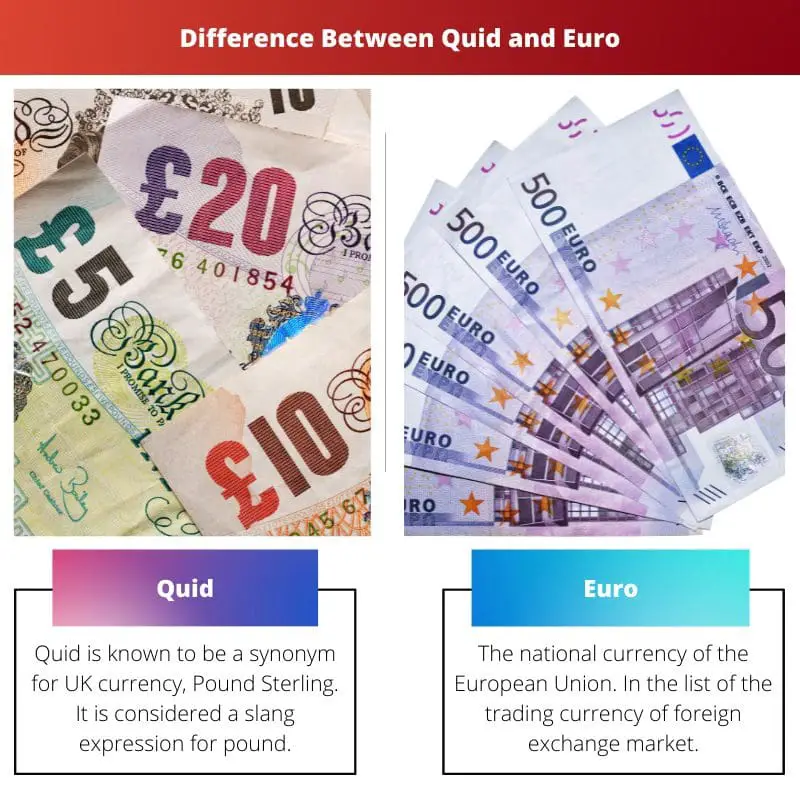Currency is the medium of exchange of goods and services authorized by the government of a particular country. Currency is the backbone of an independent and strong nation. There are about 180 different types of currencies across the world.
Among the leading 8 currencies, the United Kingdom (UK) has Pound Sterling or Quid, and Euro is the currency of the European Union; these are the top currencies worldwide. Starting from their origin, symbol, and value, they are entirely different.
This leads to a curiosity about knowing the facts about these leading players worldwide.
Key Takeaways
- Quid is a slang term used for the British Pound, the official currency of the United Kingdom, while Euro is the official currency of the Eurozone.
- The exchange rate between the two currencies is variable and changes daily based on several economic and political factors.
- While both currencies are widely accepted in several countries, the exchange rate of each currency can significantly impact the purchasing power of individuals travelling to different regions.
Quid vs Euro
Quid is a slang term used for Pound Sterling. 1 Quid has equalled 100 pence, and on the other hand, 1 Euro equals 100 cents.

Quid originated from the Latin quid pro quo meaning “an equal exchange or substitution”. It is considered an informal nickname for the official currency of the UK Pound Sterling. It is the world’s third most used trading currency in foreign exchange markets.
The symbol for quid is £, and its ISO code is GBP. The basic unit of quid is pence (singular penny).
Euro is the official currency of 19 out of 27 member states of the European Union. This is the second-largest and second-most used currency worldwide after the US dollar. The symbol of the money Euro is €, and the ISO code for it is EUR. The basic unit of the Euro is cents.
Comparison Table
| Parameters of Comparison | Quid | Euro |
|---|---|---|
| Adopted By Countries | United Kingdom (9 British territories) | European Union (19 out of 27 member states) |
| ISO 4217 code | GBP | EUR |
| Origin | It is derived from a Latin phrase | It is the abbreviation of European |
| Basic unit | Pence | Cents |
| Values in the foreign exchange market | 1.59 USD | 1.49 USD |
| Governing bank | Bank Of England (BoE) | European Central Bank (ECB) |
| Official name | Pound Sterling | Euro |
| Frequently used Coins | 1p ,2p, 5p, 10p, 20p, 50p, £1, £2 | 5c, 10c, 20c, 50c,€1, €2 |
| Frequently used banknotes | £5, £10, £20, £50 | €5, €10, €20, €50, €100 |
| Inflation | 1.4% (12 months in December 2019) | -0.3% (2020) |
What is Quid?
Quid is known to be a synonym for the UK currency, Pound Sterling. It is considered a slang expression for pound.
The fact is still unknown is how it became a synonym of the British currency. From this way, it is assumed that there was a Royal Mint paper mill in a village called Quidhampton in Wiltshire, England.
It is assumed that the paper money printed from this mint was called quid by the villagers, and from there, this name originated.
Quid is officially called the Pound Sterling. Though the quid is considered informal, the Pound Sterling is regarded as the national currency. The United Kingdom consists of 9 British Territories. In the trading currency list for the foreign exchange market, the Quid occupies third place.
The symbol of quid is £, and the abbreviation is GBP. The basic unit of Quid is Pence (singular penny) and is abbreviated as p.
1 Quid (£) = 100 pence (p)
1p, 2p, 5p, 10p, 20p, 50p, £1, £2 and £5, £10, £20, and £50 are the most circulating coins and notes around the UK. King William III first introduced the banknotes in his established Bank of England in 1694. At that time, they were handwritten and evolved into modern banknotes in modern times.
The monetary inflation of Quid was 1.4% in 2019. The reserve exchange currency of Quid was 4.62% in 2019.

What is Euro?
The national currency of the European Union. In the list of the trading currency of the foreign exchange market, it occupies a prestigious place second. It is officially used by 19 out of 27 member states. The symbol of the euro is €, and the abbreviation is EUR. The basic unit of the Euro is Cent (c).
1 Euro (€) =100 cents (c)
The name Euro was abbreviated from European and was derived from the Latin word “Europa”. It was the most-voted name from the Maastricht Treaty 1991. The Maastricht treaty is a union of 12 member countries under the European Union.
These countries formed a group to standardize a standard unit for monetary exchange in the EU. It was adopted on 16 December 1995. The currency first appeared in the market in 1999. The new Euro coins and notes appeared on 1 January 2002.
The reserve bank of the European Union is the European Central Bank. It was established in Frankfurt, Germany.
It is the administration for circulating coins and banknotes in the EU. 5c, 10c, 20c, 50c, €1, €2 and €5, €10, €20, €50, and €100 are the most circulating coins and notes, respectively, in the EU. The rarely used coins are 1c and 2c.
The increase in the money supply is called monetary inflation. The inflation of the Euro is -0.3% in 2020. In 2018, about 21 billion euro banknotes and almost 130 billion Euro coins were in circulation. After the US dollar, the Euro is holding its place as the reserve currency around the world.
It increased from 18% in 1999 to 27% in 2008 and dropped to 20.54% in 2019.

Main Differences Between Quid And Euro
- Quid is a UK currency, whereas Euro is a European Union currency.
- Quid is an informal name, whereas Euro is an official currency name.
- One Quid equalled 100 pence, whereas one Euro equals 100 cents.
- The governing bank of quid is the Bank of England; on the other hand, Euro is governed by European Central Bank.
- The quid appeared in 1489, and the Euro appeared in 1999.
- The value of the Quid is higher in foreign markets than in the Euro.
- The symbol of the quid is £, and the symbol of the Euro is €.
- The Reserve Currency of the Quid is 4.62%, and Euro was 20.54% in 2019.





